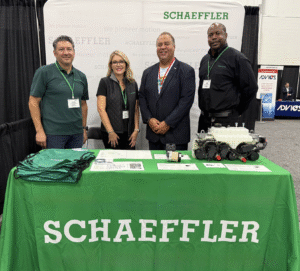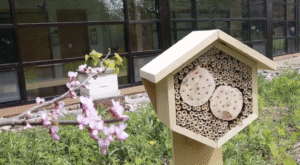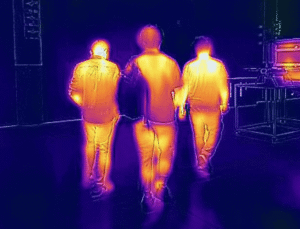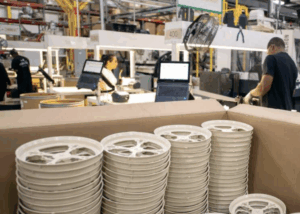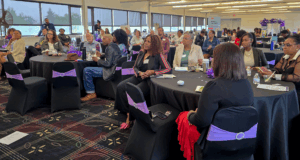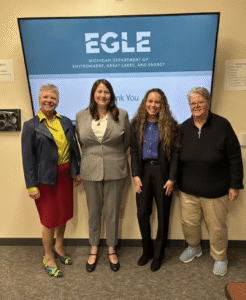
- Kim Kisner
- Education
- 09/23/2024
Wayne State University’s New Sustainability Leader Outlines Plans

In May, Edna Lorenz, PE, CEM, LEED AP, took on the role of Director of the Office of Campus Sustainability at Wayne State University.
Previously, she served as the Energy Director at Corewell Health (formerly Beaumont Health), where she led a comprehensive energy and carbon reduction program across 22 hospitals.
Before Corewell Health, Lorenz was a senior associate at Environmental Systems Design (now Stantec) in Chicago, managing LEED certification projects, energy audits, and renewable energy analysis.
Here, she discusses the role, priorities, and future of sustainability at the university with SBN Detroit.

Q: What led you to your current position?
A: I am a mechanical engineer by training, having graduated from the University of Michigan. My first job out of college was with an engineering firm where I focused on energy and sustainability consulting for commercial buildings, with a specialization in the LEED green building rating system. In 2016, I took a position as Energy Director for the Beaumont Health System, now Corewell Health.
While at Corewell, I found it very rewarding working on the operational side of the built environment, specifically optimizing building performance to reduce the energy consumption and carbon footprint of the hospital system’s 22 campuses. However, I wanted to get back to my green roots. I transitioned to higher education and began my role at Wayne State in May. It’s been fulfilling to work with a larger community, both on campus and within Detroit, who are deeply committed to sustainability. The students in particular are enthusiastic and have high expectations, which is very energizing.
Q: What are your top priorities in this new role?
A: My primary focus is to operationalize sustainability across the campus. We have a strategic framework, and I want to ensure our approach is practical and achievable for those executing the work.
Initially, we are benchmarking current processes to identify what is working well, what isn’t, and where gaps exist. I am also collaborating with the academic side to integrate sustainability into all aspects of university life.
Energy reduction is a top priority, and we have a strategic goal to reduce carbon emissions from building operations by at least 50% by 2030. Currently, we’re evaluating our buildings to find opportunities for both operational optimization as well as infrastructure improvement.

Additionally, we are enhancing our waste management program by benchmarking current practices and identifying areas for improvement.
We’re also focused on landscape and hardscape management to improve stormwater management and increase site permeability. We’re adding more trees and removing or replacing concrete with permeable pavers to achieve this and to enhance the campus’s appeal as a park-like community resource.
Q: What strategies is the university implementing to reduce its carbon footprint?
A: One great example is our student-run compost program. Our ‘Compost Warriors’ collect pre-consumer food waste — food scraps from food prep on campus — and transport it to the Georgia Street Collective, where it’s processed into nutrient-rich compost. Our grounds crew then uses it to fertilize the landscaping on campus. It’s a closed-loop process that reduces our carbon footprint while supporting a local organization.
However, much of our scope 1 and 2 carbon emissions come from energy consumed by our buildings on campus. An example of how we are trying to reduce these emissions includes the installation and enhancement of automated controls for our buildings’ HVAC and electrical systems. By having the most up-to-date automation we can optimize how our buildings operate, from adjusting temperature controls based on outside conditions to turning off equipment when it is not needed.
Q: What about recycling on campus?
A: We are still working on benchmarking this area and have found it challenging to obtain accurate data due to the size of campus operations. Therefore, one of our first initiatives is to enlist students to help map waste stations around campus so we can chart the flow of waste leaving campus.
We are also assessing the different types of waste streams, from hazardous waste from labs to construction waste from building renovations and used sports gear from the athletic department. Our aim is to identify all waste streams and find ways to divert as much as possible from landfills.
Finally, we’re also looking at expanding the compost program at the Towers Café, a residential dining hall, with a pilot program this fall to divert post-consumer food waste as well as educate students on reducing overconsumption.
Q: How are you addressing stormwater runoff management?
A: Stormwater management is a significant issue in Midtown, where urban flooding has occurred. It’s a priority for us and our neighbors to explore ways to reduce runoff and prevent future flooding events.
One of our major initiatives is to reduce hardscape and install more bioswales on campus as well as plant more trees and native vegetation. This will help reduce runoff and absorb more water onsite. A couple of examples of the progress we have made include installing permeable pavers on Anthony Wayne Drive in front of the residence hall as well as annual tree planting volunteer events with the Green Warrior student organization and our grounds crew.
Q: What are the sustainable practices unique to the urban built environment?
A: Being in an urban environment has its advantages. We have access to public transportation, and students and faculty can easily walk or bike to local amenities, which reduces fossil fuel emissions and the immense energy and materials needed to build private vehicles.
However, challenges like air quality and urban heat islands also exist, but our campus has over 2,000 trees to help combat these issues, and we’ve been recognized as a Tree Campus by the Arbor Day Foundation, which we are very proud of.

Our goal is to serve as a model for urban sustainability for other organizations and institutions of higher education.
Q: How are students, faculty, and staff involved in sustainability efforts at Wayne State?
A: Students are heavily involved. In addition to the Green Warriors and compost program, we work with our academic partners to identify projects that students can help execute which include documenting or creating recommendations for sustainability programs on campus.
The university has a President’s Sustainability Council that collaborates on sustainability initiatives on the faculty side and provides input on events and initiatives. We also partner with the United Nations Regional Center of Excellence between Detroit and Windsor to address regional sustainability needs and integrate them into our educational curriculum.
Q: How does Wayne State collaborate with the Detroit community on sustainability initiatives?
A: Wayne State is an active member of Midtown and frequently collaborates with community-based organizations like the Georgia Street Collective, the Greening of Detroit, and Make Food Not Waste for sustainability initiatives such as composting and tree planting.
Also, as we develop our master landscaping plan, we will seek input from the community to ensure their needs and wants are also addressed. Our vision is for the campus to be a place of respite and a park-like resource for the neighborhood.
Q: What metrics do you use to measure the success of sustainability programs at Wayne State?
A: We track various metrics, such as energy and water consumption across buildings and the weight of composted waste collected by the Compost Warriors, to gauge the effectiveness of our composting program. We are also currently developing key performance indicators (KPIs) to align with our strategic framework to evaluate and enhance our sustainability goals.
We also monitor engagement metrics, such as participation in student organizations like the Green Warriors and involvement in campus sustainability activities such as our annual “Green Street” events in October, which includes a panel discussion, volunteer opportunities, and other events to promote sustainability and community engagement.
Q: What challenges do you anticipate?
A: Obtaining accurate data is a challenge since we are tracking multiple initiatives and are working with many different data streams. This will only get more complicated as we start working on Scope 3 emissions, which is a large undertaking.
Q: How will you work to enhance a culture of sustainability at Wayne State?
A: We aim to make sustainability feel accessible rather than burdensome. For instance, we don’t want people to struggle to find a recycling bin or decipher complicated signs. Our goal is to make sustainable choices easy and intuitive.
We also want sustainability to be integrated into all aspects of campus life, including academics. Currently, our Office of Sustainability interns are primarily from environmental sciences, but we’d like to encourage broader participation from other departments to foster a campus-wide commitment.
Q: What is your vision for the future of sustainability at Wayne State?
A: My long-term goal is to develop a strategic approach by understanding our current status, planning for our future direction, and continually engaging with students, staff, and faculty to stay on the right path.
Students have high expectations for our sustainability efforts, such as recycling, and they see room for improvement. Listening to students presents a great opportunity to guide the institution’s direction on sustainability.
I envision Wayne State as a model for other urban institutions and I think we can get there through our development of high-performance building operations, an enhanced urban ecology, a parklike campus, and a circular waste management system.
Be sure to subscribe to our newsletter for regular updates on sustainable business practices in and around Detroit.
Kim Kisner
- All
- Business
- Community
- Education
- Events
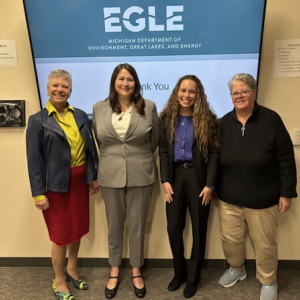
Butzel is one of Michigan’s longest-standing law firms, advising businesses across industries on regulatory compliance, environmental law, and complex commercial matters. As environmental expectations evolve alongside shifting regulatory realities, the firm plays a key role in helping companies navigate both legacy challenges and emerging risks. SBN Detroit interviewed Butzel shareholder Beth Gotthelf to discuss how environmental compliance, sustainability, and innovation are intersecting today — particularly in Southeast Michigan...

Schaeffler is a global automotive and industrial supplier with operations in Southeast Michigan, where it works across the region’s manufacturing and supplier network. As sustainability, decarbonization and supply chain resilience become central to how products are designed and sourced, the region’s role in shaping next-generation manufacturing continues to evolve. SBN Detroit interviewed Courtney Quenneville, who oversees supplier sustainability, to discuss the realities of sustainable sourcing, what decarbonizing a...
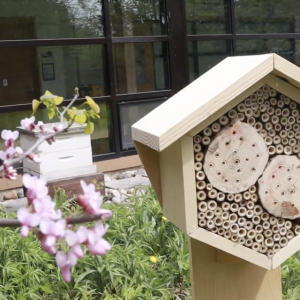
Pollinators are essential to Michigan’s ecosystems, food systems, and long-term environmental resilience — yet they face increasing threats from habitat loss, pesticides, disease, and climate change. As Southeast Michigan looks for scalable, science-based approaches to ecological stewardship, the University of Michigan-Dearborn has emerged as a voice in pollinator conservation, sustainability, and community education. SBN Detroit interviewed Dr. David Susko, Associate Professor of Biology and Chair of Biology in...


